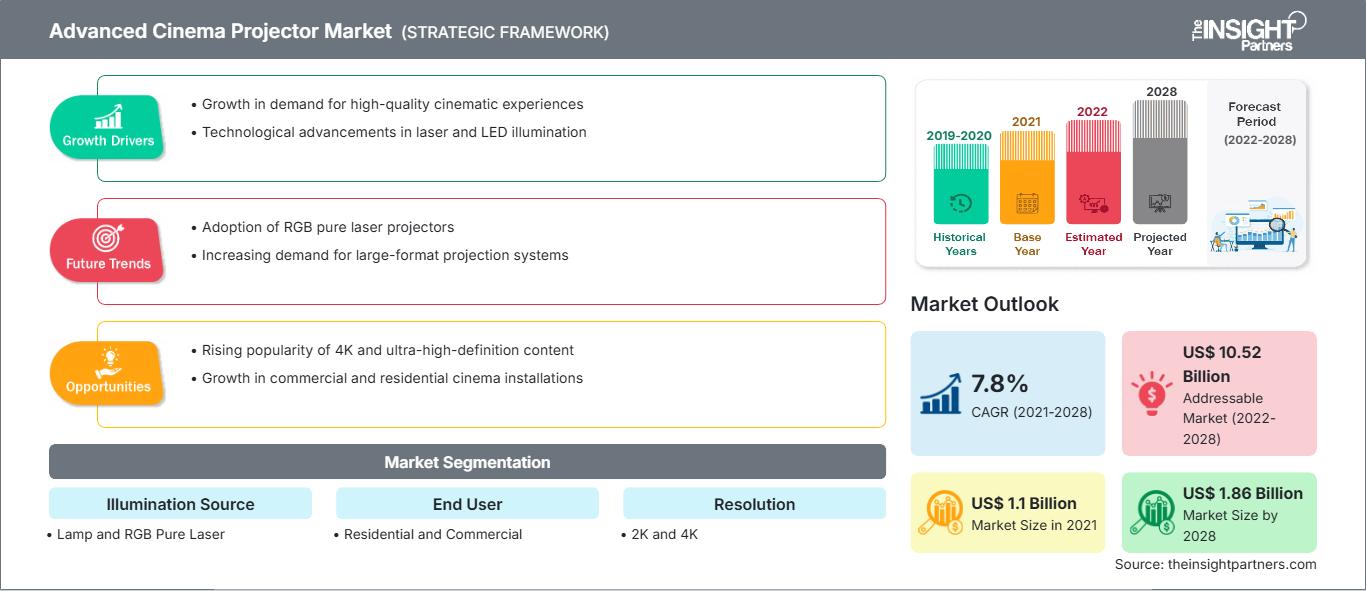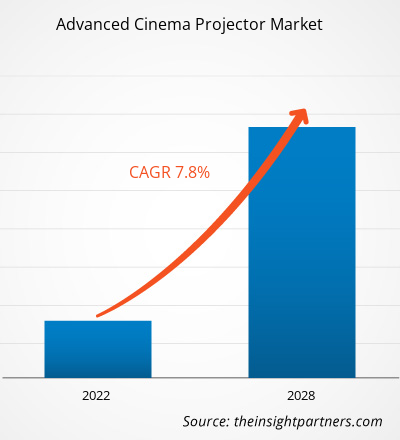[Forschungsbericht]Der Markt für fortschrittliche Kinoprojektoren soll von 1.100,69 Millionen US-Dollar im Jahr 2021 auf 1.861,33 Millionen US-Dollar im Jahr 2028 wachsen; von 2021 bis 2028 wird mit einer durchschnittlichen jährlichen Wachstumsrate von 7,8 % gerechnet.
Die rasant steigende Nachfrage nach fortschrittlichen Technologien in der Filmindustrie und die zunehmende Installation digitaler Displays treiben den Markt für fortschrittliche Kinoprojektoren weltweit an. Die fortschrittlichen Kinoprojektoren projizieren effizient ein Bild auf eine große Fläche wie eine weiße Leinwand oder eine Wand und werden als Alternative zu einem Fernseher oder Monitor verwendet, um Videos oder Bilder einem großen Publikum zu präsentieren. Steigendes verfügbares Einkommen der Menschen, die steigende Zahl von Kinosälen/Theatern/Multiplexen und die stark steigende Zahl von Kinobesuchern weltweit zwingen die Marktteilnehmer, technologisch fortschrittliche Kinoprojektoren zu entwickeln. Darüber hinaus steigert die zunehmende Entwicklung von 3D-Filmen durch Produktionshäuser, um den Zuschauern ein verbessertes Erlebnis zu bieten, die Nachfrage nach modernen 3D-Laserprojektoren.
Die Vorteile moderner Kinoprojektoren wie bessere Bildqualität, verbesserte Helligkeit und Farbfunktionen, die das visuelle Gesamterlebnis des Zuschauers verbessern, treiben den Markt weltweit an. Während der COVID-19-Pandemie ist die Nachfrage nach modernen Kinoprojektoren für den Einsatz im privaten Bereich aufgrund der verbesserten Flexibilität, Farbgenauigkeit, unglaublichen Helligkeit und Mobilität enorm gestiegen. Auch die steigende Nachfrage nach Sportveranstaltungen in Clubs, Restaurants, Hotels und Open-Air-Kinos unterstützt das Wachstum kommerzieller moderner Kinoprojektoren und fördert deren Akzeptanz auf dem Markt.
Passen Sie diesen Bericht Ihren Anforderungen an
Sie erhalten kostenlos Anpassungen an jedem Bericht, einschließlich Teilen dieses Berichts oder einer Analyse auf Länderebene, eines Excel-Datenpakets sowie tolle Angebote und Rabatte für Start-ups und Universitäten.
Markt für fortschrittliche Kinoprojektoren: Strategische Einblicke

- Holen Sie sich die wichtigsten Markttrends aus diesem Bericht.Dieses KOSTENLOSE Beispiel umfasst Datenanalysen, die von Markttrends bis hin zu Schätzungen und Prognosen reichen.
Auswirkungen der COVID-19-Pandemie auf den Markt für moderne Kinoprojektoren
Sie erhalten kostenlos Anpassungen an jedem Bericht, einschließlich Teilen dieses Berichts oder einer Analyse auf Länderebene, eines Excel-Datenpakets sowie tolle Angebote und Rabatte für Start-ups und Universitäten.
Markt für fortschrittliche Kinoprojektoren: Strategische Einblicke

- Holen Sie sich die wichtigsten Markttrends aus diesem Bericht.Dieses KOSTENLOSE Beispiel umfasst Datenanalysen, die von Markttrends bis hin zu Schätzungen und Prognosen reichen.
Die COVID-19-Pandemie hat mehrere Branchen weltweit hart getroffen und dadurch die Nachfrage nach verschiedenen Produkten der Elektronikindustrie dezimiert. Die Akteure der Elektronikindustrie mussten 2020 einen starken Rückgang ihrer Einnahmen hinnehmen, seit Anfang 2021 verzeichnen die Unternehmen jedoch in bestimmten Ländern ein bemerkenswertes Wachstum ihrer Produkte. Auch die Hersteller von Kinoprojektoren mussten Umsatzrückgänge hinnehmen, da die Nachfrage stark zurückging, als die meisten Kinos von den Regierungen geschlossen wurden, um die Verbreitung von COVID-19 einzudämmen. Dies führte zu Einnahmeverlusten bei den Kinobesitzern, was diese wiederum daran hinderte, sich für moderne Projektionslösungen zu entscheiden, um das Kundenerlebnis zu verbessern. Dieser Parameter behinderte das Wachstum des Marktes für moderne Kinoprojektoren im Jahr 2020. Neben Kinos werden Kinoprojektoren auch von verschiedenen Restaurants und Hotels zur Unterhaltung ihrer Kunden beschafft. Das Auftreten und die schnelle Verbreitung des COVID-19-Virus zwangen das Gastgewerbe jedoch dazu, seine Geschäfte vorübergehend einzustellen, was den Kauf neuerer oder modernerer Projektoren erneut einschränkte. Dies behinderte letztlich die Geschäfte der Akteure auf dem Markt für moderne Kinoprojektoren. Neben der Nachfrageseite beeinflusste auch die Angebotsseite des Marktes für moderne Kinoprojektoren das Marktwachstum. Dies betrifft die Schließung von Grenzen, die zu Unterbrechungen der Lieferkette mehrerer Komponenten/Teile führte. Dies führte zu einer Verringerung der Produktionsmengen und wirkte sich somit negativ auf das Marktwachstum aus.
Markteinblicke für moderne Kinoprojektoren: Steigende Akzeptanz moderner Kinoprojektoren im privaten Sektor weltweit
Moderne Kinoprojektoren für den privaten Gebrauch erfreuen sich auf dem Markt ständiger Beliebtheit, da die Kunden ein hochwertiges visuelles Erlebnis zu Hause haben möchten. Darüber hinaus fördern die zunehmende Kaufkraft und das steigende verfügbare Einkommen die Akzeptanz moderner Kinoprojektoren als Heimkinoanwendung. Auch die von den Regierungen verhängten Lockdowns zur Eindämmung der Verbreitung von COVID-19 haben die Nachfrage nach modernen Kinoprojektoren weiter angekurbelt. Daher kaufen die Kunden neue Home-Entertainment-Produkte wie moderne Kinoprojektoren, um ihre Zeit während der Pandemie zu Hause zu genießen. Im September 2020 stellte BenQ in Indien beispielsweise den neuen BenQ TH585 vor, einen Full-HD-Home-Entertainment-Projektor. Dieser neue Projektor bietet eine hohe Auflösung und Bildqualität, damit Kunden Filme und Shows zu Hause auf dem Bildschirm ansehen können.
Markteinblicke basierend auf Illusionsquellen
Basierend auf der Beleuchtungsquelle ist der Markt in Lampen und RGB-Laser unterteilt. Die herkömmlichen Projektoren integrieren Lampen zur Lichterzeugung, und mit dem technologischen Fortschritt werden RGB-Laserprojektoren entwickelt, die eine verbesserte Licht- und Farbqualität bieten. Das RGB-Lasersegment dominiert den Markt und wird dies voraussichtlich auch im Prognosezeitraum bleiben.
Markteinblicke basierend auf Endbenutzern
Basierend auf dem Endbenutzer ist der Markt in private und gewerbliche Zwecke unterteilt. Das kommerzielle Segment dominiert den Markt, da die meisten Kinos Laserprojektoren verwenden und die Nachfrage nach einer Umstellung von 2K auf 4K unter den Kinobesitzern wächst. Dies treibt das kommerzielle Segment im Markt für moderne Kinoprojektoren voran. Andererseits steigt mit dem steigenden verfügbaren Einkommen der Menschen weltweit und aufgrund der Auswirkungen von COVID-19 die Nachfrage nach Projektoren für den Heimgebrauch weltweit.
Die Akteure im Markt für moderne Kinoprojektoren verfolgen Strategien wie Fusionen, Übernahmen und Marktinitiativen, um ihre Position auf dem Markt zu behaupten. Einige Entwicklungen der wichtigsten Akteure sind unten aufgeführt:
- Im Jahr 2021 ist Cinionic (Barco NV) eine Partnerschaft mit Cine Colombia eingegangen. Der Deal ist der Höhepunkt der kontinuierlichen Unterstützung von Cinionic für Cine Colombia, den größten Kinobetreiber Kolumbiens mit 339 Kinosälen an 46 Standorten.
- Im Jahr 2020 hatten Sharp Corporation und NEC Corporation ein Joint Venture gegründet, um ihre Geschäftsbereiche für Displaylösungen zu bündeln. Gemeinsam werden sie unter dem neuen Namen Sharp NEC Display Solutions Ltd. Displaylösungen wie Projektoren anbieten. Dieses Joint Venture schafft eine neue Möglichkeit, seinen Kunden weltweit qualitativ hochwertige, innovative Lösungen anzubieten.
Advanced Cinema ProjectorRegionale Einblicke in den Markt für fortschrittliche Kinoprojektoren
Die Analysten von The Insight Partners haben die regionalen Trends und Faktoren, die den Markt für moderne Kinoprojektoren im Prognosezeitraum beeinflussen, ausführlich erläutert. In diesem Abschnitt werden auch die Marktsegmente und die geografische Lage in Nordamerika, Europa, dem asiatisch-pazifischen Raum, dem Nahen Osten und Afrika sowie Süd- und Mittelamerika erörtert.
Umfang des Marktberichts zu fortschrittlichen Kinoprojektoren
| Berichtsattribut | Einzelheiten |
|---|---|
| Marktgröße in 2021 | US$ 1.1 Billion |
| Marktgröße nach 2028 | US$ 1.86 Billion |
| Globale CAGR (2021 - 2028) | 7.8% |
| Historische Daten | 2019-2020 |
| Prognosezeitraum | 2022-2028 |
| Abgedeckte Segmente |
By Beleuchtungsquelle
|
| Abgedeckte Regionen und Länder | Nordamerika
|
| Marktführer und wichtige Unternehmensprofile |
|
Dichte der Marktteilnehmer für fortschrittliche Kinoprojektoren: Verständnis ihrer Auswirkungen auf die Geschäftsdynamik
Der Markt für moderne Kinoprojektoren wächst rasant. Die steigende Nachfrage der Endverbraucher ist auf Faktoren wie veränderte Verbraucherpräferenzen, technologische Fortschritte und ein stärkeres Bewusstsein für die Produktvorteile zurückzuführen. Mit der steigenden Nachfrage erweitern Unternehmen ihr Angebot, entwickeln Innovationen, um den Bedürfnissen der Verbraucher gerecht zu werden, und nutzen neue Trends, was das Marktwachstum weiter ankurbelt.

- Holen Sie sich die Markt für fortschrittliche Kinoprojektoren Übersicht der wichtigsten Akteure
- Lampe
- RGB Pure Laser
Markt für fortschrittliche Kinoprojektoren – nach Endbenutzer
- Privat
- Gewerblich
Markt für fortschrittliche Kinoprojektoren – nach Auflösung
- 2K
- 4K
Markt für fortschrittliche Kinoprojektoren – nach Lumen
- 1000 – 5000
- 5001 – 10000
- 10001 – 30000
- Über 30000
Markt für fortschrittliche Kinoprojektoren – nach Geografie
Nordamerika
- USA
- Kanada
- Mexiko
Europa
- Frankreich
- Deutschland
- Italien
- Russland
- Großbritannien
- Russland
- Rest von Europa
Asien-Pazifik (APAC)
- China
- Indien
- Japan
- Australien
- Südkorea
- Rest von APAC
Naher Osten und Afrika (MEA)
- Saudi-Arabien
- VAE
- Südafrika
- Rest von MEA
Süd- und Mittelamerika (SAM)
- Brasilien
- Argentinien
- Rest von SAM
Firmenprofile
- Barco NV
- BENQ Corporation
- Christie Digital
- Delta Electronics, Inc.
- Hitachi Ltd.
- Infocus Corporation
- LG Electronics Inc.
- Optoma Corporation (Coretronic Corporation)
- Panasonic Corporation
- Sharp Corporation
- Historische Analyse (2 Jahre), Basisjahr, Prognose (7 Jahre) mit CAGR
- PEST- und SWOT-Analyse
- Marktgröße Wert/Volumen – Global, Regional, Land
- Branchen- und Wettbewerbslandschaft
- Excel-Datensatz
Aktuelle Berichte
Erfahrungsberichte
Grund zum Kauf
- Fundierte Entscheidungsfindung
- Marktdynamik verstehen
- Wettbewerbsanalyse
- Kundeneinblicke
- Marktprognosen
- Risikominimierung
- Strategische Planung
- Investitionsbegründung
- Identifizierung neuer Märkte
- Verbesserung von Marketingstrategien
- Steigerung der Betriebseffizienz
- Anpassung an regulatorische Trends




















 Kostenlose Probe anfordern für - Markt für fortschrittliche Kinoprojektoren
Kostenlose Probe anfordern für - Markt für fortschrittliche Kinoprojektoren